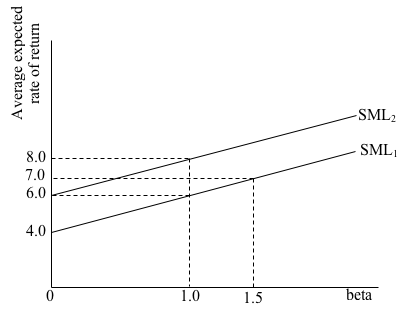 |
| 1 |  | 
Which of the following correctly expresses the relationship between dollars received today and dollars received in the future? If i is the interest rate, then: |
|  | A) | X dollars today = (1 + i)Xt dollars in t years |
|  | B) | X dollars today = (1 + i)tX dollars in t years |
|  | C) | X t/(1+i) dollars today = X dollars in t years |
|  | D) | X/t dollars today = X dollars in t years |
|
|
 |
| 2 |  | 
Refer to the following diagram:
 <a onClick="window.open('/olcweb/cgi/pluginpop.cgi?it=gif::::/sites/dl/free/0073273082/384258/quiz14webc_2.gif','popWin', 'width=NaN,height=NaN,resizable,scrollbars');" href="#"><img valign="absmiddle" height="16" width="16" border="0" src="/olcweb/styles/shared/linkicons/image.gif"> (7.0K)</a> <a onClick="window.open('/olcweb/cgi/pluginpop.cgi?it=gif::::/sites/dl/free/0073273082/384258/quiz14webc_2.gif','popWin', 'width=NaN,height=NaN,resizable,scrollbars');" href="#"><img valign="absmiddle" height="16" width="16" border="0" src="/olcweb/styles/shared/linkicons/image.gif"> (7.0K)</a>
If the security market line is given by SML1, what is the risk premium associated with the overall market? |
|  | A) | 2% |
|  | B) | 3% |
|  | C) | 4% |
|  | D) | 6% |
|
|
 |
| 3 |  | 
Refer to the following diagram:
 <a onClick="window.open('/olcweb/cgi/pluginpop.cgi?it=gif::::/sites/dl/free/0073273082/384258/quiz14webc_2.gif','popWin', 'width=NaN,height=NaN,resizable,scrollbars');" href="#"><img valign="absmiddle" height="16" width="16" border="0" src="/olcweb/styles/shared/linkicons/image.gif"> (7.0K)</a> <a onClick="window.open('/olcweb/cgi/pluginpop.cgi?it=gif::::/sites/dl/free/0073273082/384258/quiz14webc_2.gif','popWin', 'width=NaN,height=NaN,resizable,scrollbars');" href="#"><img valign="absmiddle" height="16" width="16" border="0" src="/olcweb/styles/shared/linkicons/image.gif"> (7.0K)</a>
Which of the following will cause a shift of the security market line from SML1 to SML2? |
|  | A) | A change in Federal Reserve Bank policy raises the interest rate on government securities |
|  | B) | consumer preferences change such that they no longer require as much compensation for risk |
|  | C) | consumer preferences change such that they now require more compensation for risk |
|  | D) | overall market risk falls |
|
|
 |
| 4 |  | 
If the risk-free interest rate is 10%, which of the following assets has a present value of $100? |
|  | A) | A bond that pays $10 at the end of each of the first two years, returning the $100 principal at the end of the second year |
|  | B) | A bond that pays no interest but can be cashed in for $121 at the end of the second year |
|  | C) | A stock that pays a $10 dividend at the end of each of the first 3 years and can be sold at the end of the third year for $100. |
|  | D) | All of the above |
|
|
 |
| 5 |  | 
Consider a stock that is currently priced at $500. At the end of one year, there is a 10% chance that the firm will go bankrupt and the stock will be worthless. However, there is a 60% chance that the stock price will rise to $600 and a 30% chance that it will fall to $400. The expected rate of return on this asset is: |
|  | A) | -4% |
|  | B) | 4% |
|  | C) | 8% |
|  | D) | 16% |
|
|
 |
| 6 |  | 
All else equal, an asset's expected rate of return is: |
|  | A) | inversely related both to its price and its level of risk |
|  | B) | directly related both to its price and its level of risk |
|  | C) | directly related to its price and inversely related to its level of risk |
|  | D) | inversely related to its price and directly related to its level of risk |
|
|
 |
| 7 |  | 
Suppose a financial asset has a 10% expected rate of return and a risk premium of 4%. From this one may infer that: |
|  | A) | the risk-free rate of return is 4% |
|  | B) | the asset's beta is 4 |
|  | C) | the price of the asset will rise by 14% each year |
|  | D) | the risk-free rate of return is 6% |
|
|
 |
| 8 |  | 
Suppose the stock of medical technology companies R and S both have the same beta value of 2.8. However, recent news reports suggest that company R's breakthrough technology is soon likely to be approved by the Food and Drug Administration. This news raises its expected rate of return relative to company S stock. Arbitrage suggests that investors will likely: |
|  | A) | sell shares in R and buy shares in S until their expected returns equalize |
|  | B) | sell shares in S and buy shares in R until their expected returns equalize |
|  | C) | raise their assessment of the risk of R, lowering its beta |
|  | D) | raise their assessment of the risk of S, raising its beta. |
|
|
 |
| 9 |  | 
The steeper the security market line, the: |
|  | A) | higher the risk-free interest rate |
|  | B) | the greater the risk level of the overall market |
|  | C) | the greater the compensation investors demand for any increase in risk |
|  | D) | higher is beta |
|
|
 |
| 10 |  | 
If the risk-free interest rate is 8%, what is the present value of a financial asset that will pay $1000 one year from now? |
|  | A) | $80 |
|  | B) | $1080 |
|  | C) | $920 |
|  | D) | $925.93 |
|
|

